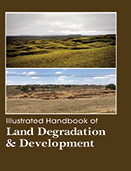Agriculture and Life Sciences

Land degradation is a concept in which the value of the biophysical environment is affected by one or more combination of human induced processes acting upon the land. It literally refers to the impairment of natural quality of soil component of any ecosystem. Land degradation which is also seen as a decline in land quality caused by human activities, has been a major global issue since the 20th century and it has remained high on the international agenda in the 21st century. The importance of land degradation is enhanced because of its impact on food security and quality of the environments. Land resources are nonrenewable and it is necessary to adopt a positive approach to ensure sustainable management of these finite resources.
Illustrated Handbook of Land Degradation & Development addresses the concept of land degradation, major causes of land degradation including, land clearance poor farming practices, overgrazing, and inappropriate irrigation, urban sprawl, and commercial development, land pollution including industrial waste and quarrying of stone, sand and minerals. It further revealed that, severe land degradation has affected significant part of arable land, decreasing the wealth and economic development. As land becomes less productive, food security is compromised and competition for dwindling resources increases, the seeds of famine and potential conflict are sown. It also focuses on why land quality information is important for sustainable development and how it can be used more effectively for planning and decision making.
Vulnerable lands are exposed to stresses such as accelerated soil erosion by water, soil acidification and the formation of acid sulphates resulting in barren soil, and reduced crop yields. Agricultural activities such as shifting cultivation, without adequate fallow periods, absence of soil conservation measures, fertilizer use and a host of possible problems arising from faulty planning or management of the land all lead to intense land degradation.
This Illustrated Handbook of Land Degradation & Development focuses on the global effects of land degradation, but emphasizes other important levels of land degradation. It presents a broad multi-disciplinary perspective on the challenge of problems of degrading land. It also describes on-the-ground realities of policy making and implementation in the field of land development, and illustrates how a rigid central planning system works in practice.